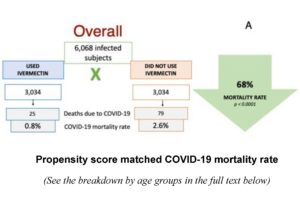 Cureus, 2022 Jan 15;14(1):e21272. Kerr, Cadegiani, Baldi, Lobo, … Chamie-Quintero.
Cureus, 2022 Jan 15;14(1):e21272. Kerr, Cadegiani, Baldi, Lobo, … Chamie-Quintero.
The discussion of this paper begins at about Minute 8 in the video below.
The entire population of a city in Brazil was invited to take Ivermectin at a dose of 0.2 mg/kg per day for two consecutive days every 15 days.
This was a very low dose of Ivermectin, actually, which runs the risk of showing no clear advantage — but it did, actually, even with this small dose used as prophylaxis.
There was 44% less infection in the Ivermectin group (even at that low dose) and a 68% reduction in death. In fact, only 0.8% of the Ivermectin group died, while 2.6% of the non-users group died. This comes out to be a 70% reduction in mortality, with a 1 in 10,000 possibility that it could have been by chance (P < 0.0001). In other words, this finding is very significant and it is real — it is nearly impossible that it could have happened by chance.
As Dr. Campbell said, “Why isn’t this in the newspapers?” It is almost (he said) “as if information has been deliberately suppressed throughout the pandemic.” He was quick to add, however, that “no-one is saying that’s true, of course.” Be careful, Dr. Campbell. We love your tutorials. And we agree with you, as you add, “70%? How can you argue with a number like that?”
EDITED 3/19/2022: Unfortunately, the “fact checkers” decided that they don’t like this video, and they have removed it altogether. So instead of Dr. Campbell leading you through the study, spend a few minutes reading it yourself before it, too, is removed. Such is the state of science today.




















